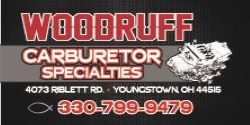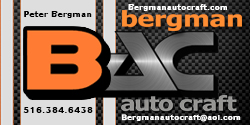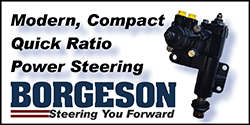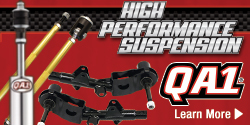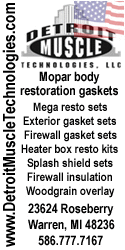Thermo-Quad number 9372S was originally equipped on 1981-1982 318 passenger car federal (non-California, non-Canada) applications with an automatic transmission. The original Chrysler part number is 4179179.
It is one of the most complex Thermo-Quad models as an electronic feedback carburetor. To operate as intended it must be paired with an original, or similar, Electronic Spark Control (ESC)/Electronic Spark Advance (ESA) combustion computer, with accompanying sensors (including, coolant controlled vacuum switch, oxygen sensor, air inlet temperature sensor, etc.), or some other electronic feedback controller.
The feedback pulsing solenoid was used in some 1981-1984 with ESC/ESA. The solenoid mounts on the front of the bowl cover, where the Idle Enrichment module mounted earlier. This solenoid is used to control the air/fuel mixture via varying duty cycle pulsing from the control computer based on feedback from exhaust, engine, and ambient sensors. The solenoid alters the variable air bleeds by inputting more or less air based on computer signal duty cycle. If the solenoid is disconnected, the air bleeds will allow a full rich condition. Tuning with this in mind, this Thermo-Quad could potentially be used in a non-control/feedback vehicle.
In addition to the electronic feedback pulsing solenoid, this Thermo-Quad has the following systems:
- Tamper proof choke linkage.
Many 1981-1984 models have this cover to prevent field adjustment of the pull-off. It can be removed by cutting the rivets, etc.
- Bowl Vent (BV) and Bowl Vent Solenoid:
For 1978-1984 models, the standard bowl vent was redesigned with a two way valve and holding solenoid at the rear of the carburetor. When the engine starts, manifold vacuum pulls the valve rubber 'puck' down, opening the bowl to the canister port. The solenoid is connected to the ignition run circuit and holds the valve open during low vacuum periods while running. When the engine is shut down, the valve releases and reseals the float bowl. Connects to the rear base port for vacuum, color code gold. The vent hose to the canister connects to the adjacent 3/8” fitting, color code gold. This vent style is not a problem, just more complex than the earlier mechanical or internal vents.
- Ground Switch:
1976-1984 models, so equipped, use this. It signals the computer that the throttle plates are at idle position. Later models with solenoid idle stop combined the functions. It is located on the bracket on the right front. A throttle shaft attachment contacts it. The ground switch is not an issue, but its presence can preclude a conventional idle screw, which is not present on this carburetor. It can be added.
- Solenoid Idle Stop (SIS):
Used on 1981-1984 models to set the idle higher than the basic curb idle when additional heavy accessory load, such as the rear window defogger or air conditioning, is placed on the engine. It mounts on a bracket on the right front. This can be a helpful addition. It mounts with the ground switch bracket.
- Hidden idle mixture screws:
Many 1980 and later Thermo-Quads had the base redesigned to enclose the mixture screws so they could be 'capped' via plugs after factory setting. The screws can be accessed by drilling and removing the plugs. Mixture control is limited still though internally.
- Locked step-up piston adjustment:
Step up piston adjustment is not typically required, but if needed, this piston has been made non adjustable at the factory, like others from this period. It can be modified to work, or replaced by an earlier version.
- No ported vacuum port for distributor vacuum advance:
Many Electronic Lean Burn and Electronic Spark Advance/Electronic Spark Control carburetors,including this one, lack a vacuum advance port because advance was controlled by the computer. The port can be added to provide a vacuum advance signal for a conventional non-ELB/ESC/ESA distributor system. The vacuum advance port is somewhat tricky and is best performed by comparison to an earlier throttle base that has the factory port to ensure proper placement of the transfer slot. Misplacing the vacuum idle transfer slot can cause an off-idle stumble and will necessitate additional tuning or replacement.
To add the port, do the following:
1. Using a 5/32" drill bit, drill the throttle base where the vacuum port existed on previous units. Drill into the open, roughly square, opening between the outside and the throttle bore. This will accommodate the vacuum fitting.
2. Using a ~1/16" drill bit, drill two holes just above the throttle plate into the same square opening from the throttle bore side, one hole adjacent to the other and both parallel to the throttle plate.
3. Using a knife or small screwdriver, blend the holes together into a slot. This slot serves as the off-idle transfer slot to feed the vacuum port.
4. Deburr and clean the drilled areas.
5. Press a short length of 5/32" pipe or an old fitting into the outside hole.
After adding the port, ported vacuum is available for distributor vacuum advance.
This looks to be an excellent Thermo-Quad to install on a car with a functional ESC/ESA system. For adapting or modifying in a non ESC/ESA application, the foregoing details should be considered and handled depending on the application and installation goals, but for this use, starting with a simpler model would likely be better.
For more Thermo-Quad information, visit
Vaanth Thermo-Quad Guide Site.

